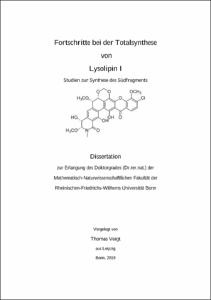Voigt, Thomas: Fortschritte bei der Totalsynthese von Lysolipin I : Studien zur Synthese des Südfragments. - Bonn, 2019. - Dissertation, Rheinische Friedrich-Wilhelms-Universität Bonn.
Online-Ausgabe in bonndoc: https://nbn-resolving.org/urn:nbn:de:hbz:5n-54729
Online-Ausgabe in bonndoc: https://nbn-resolving.org/urn:nbn:de:hbz:5n-54729
@phdthesis{handle:20.500.11811/7931,
urn: https://nbn-resolving.org/urn:nbn:de:hbz:5n-54729,
author = {{Thomas Voigt}},
title = {Fortschritte bei der Totalsynthese von Lysolipin I : Studien zur Synthese des Südfragments},
school = {Rheinische Friedrich-Wilhelms-Universität Bonn},
year = 2019,
month = may,
note = {Die vorliegende Doktorarbeit behandelt die Totalsynthese des aromatischen Polyketids Lysolipin I (1), einem potenten Antibiotikum aus dem Bakterium Streptomyces violaceoniger mit hoch modifizierten und einzigartigen Strukturmerkmalen. Es war Teil dieser Dissertation eine komplett neue Synthesestrategie zu entwickeln, die sich von früheren Versuchen diesen Naturstoff zu synthetisieren unterscheidet. Bei der Syntheseplanung wurde Lysolipin I (1) in zwei Hauptfragmente zerteilt, die über eine flexible Kupplungsstrategie miteinander verknüpft werden sollen. Der Hauptfokus dieser Arbeit liegt auf der Synthese des Südfragments 94, während die Fortschritte am Nordfragment in der künftigen Doktorarbeit von Alexander Kilian eingehend aufgezeigt werden sollen. Schlüsselschritte der Synthese des Südfragments 94 sind der Aufbau des Isochinolidinonsystems 284 über eine Pomeranz-Fritsch artige Cyclisierung, ausgehend von Amidoacetal 285, und der Einführung des syn-Diols mithilfe einer Sharpless asymmetrischen Dihydroxylierung (SAD). Besonders die Reproduzierbarkeit der Ergebnisse der SAD erschwerten ein Voranschreiten in der Synthese, dennoch konnten sämtliche Reaktion etabliert werden, die zur Vervollständigung der Synthese des Südfragments 94 notwendig sind. Diese Arbeit stellt somit eine Grundlage für die erfolgreiche Synthese des Südfragments dar, sowie der Kupplung der beiden Fragmente. In the second part of the thesis we analyze the kinematics of 283 filamentary molecular cloud candidates in the Galactic Plane, that were previously identified in the ATLASGAL (APEX Telescope Large Area Survey of the Galaxy) dust continuum data. The ccol and cool data of the SEDIGISM survey allows us to analyze the kinematics of these targets and to determine their physical properties. To do so, we developed an automated algorithm to identify all velocity components along the line- of-sight correlated with the ATLASGAL dust emission, and derive size, mass, and kinematic properties for all velocity components. We find two-third of the filament candidates are coherent structures in ppv space. Also, we find a correlation between the observed mass per unit length and the velocity dispersion of the filament of m ~ sigma^2_v. We show that this relation can be explained by a virial balance between self-gravity and pressure. Another possible explanation could be radial collapse of the filament, but the observation can exclude infall motions close to the free-fall velocity.},
url = {https://hdl.handle.net/20.500.11811/7931}
}
urn: https://nbn-resolving.org/urn:nbn:de:hbz:5n-54729,
author = {{Thomas Voigt}},
title = {Fortschritte bei der Totalsynthese von Lysolipin I : Studien zur Synthese des Südfragments},
school = {Rheinische Friedrich-Wilhelms-Universität Bonn},
year = 2019,
month = may,
note = {Die vorliegende Doktorarbeit behandelt die Totalsynthese des aromatischen Polyketids Lysolipin I (1), einem potenten Antibiotikum aus dem Bakterium Streptomyces violaceoniger mit hoch modifizierten und einzigartigen Strukturmerkmalen. Es war Teil dieser Dissertation eine komplett neue Synthesestrategie zu entwickeln, die sich von früheren Versuchen diesen Naturstoff zu synthetisieren unterscheidet. Bei der Syntheseplanung wurde Lysolipin I (1) in zwei Hauptfragmente zerteilt, die über eine flexible Kupplungsstrategie miteinander verknüpft werden sollen. Der Hauptfokus dieser Arbeit liegt auf der Synthese des Südfragments 94, während die Fortschritte am Nordfragment in der künftigen Doktorarbeit von Alexander Kilian eingehend aufgezeigt werden sollen. Schlüsselschritte der Synthese des Südfragments 94 sind der Aufbau des Isochinolidinonsystems 284 über eine Pomeranz-Fritsch artige Cyclisierung, ausgehend von Amidoacetal 285, und der Einführung des syn-Diols mithilfe einer Sharpless asymmetrischen Dihydroxylierung (SAD). Besonders die Reproduzierbarkeit der Ergebnisse der SAD erschwerten ein Voranschreiten in der Synthese, dennoch konnten sämtliche Reaktion etabliert werden, die zur Vervollständigung der Synthese des Südfragments 94 notwendig sind. Diese Arbeit stellt somit eine Grundlage für die erfolgreiche Synthese des Südfragments dar, sowie der Kupplung der beiden Fragmente. In the second part of the thesis we analyze the kinematics of 283 filamentary molecular cloud candidates in the Galactic Plane, that were previously identified in the ATLASGAL (APEX Telescope Large Area Survey of the Galaxy) dust continuum data. The ccol and cool data of the SEDIGISM survey allows us to analyze the kinematics of these targets and to determine their physical properties. To do so, we developed an automated algorithm to identify all velocity components along the line- of-sight correlated with the ATLASGAL dust emission, and derive size, mass, and kinematic properties for all velocity components. We find two-third of the filament candidates are coherent structures in ppv space. Also, we find a correlation between the observed mass per unit length and the velocity dispersion of the filament of m ~ sigma^2_v. We show that this relation can be explained by a virial balance between self-gravity and pressure. Another possible explanation could be radial collapse of the filament, but the observation can exclude infall motions close to the free-fall velocity.},
url = {https://hdl.handle.net/20.500.11811/7931}
}






